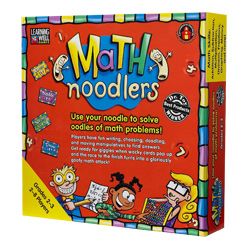Mary Margaret Pingree with Utah Idaho Supply, shares some fun ways to help kids brush-up on math.
Item #1
Counting with Coins
Play fun games with numbers while you are driving in the car, waiting to pick up someone at soccer practice or lying on the grass in the backyard. Each takes only a few minutes to play but helps your child feel comfortable with numbers and math. Here are a few simple examples:
What Are the Coins?
With your spare change, pick a few coins and put them in your pocket. Then tell your child how much they are worth. Have your child guess the types of coins you have. Give them a turn when they guess it right. Here are some examples:
• I have three coins in my pocket. They are worth 7 cents. What
do I have? (a nickel and 2 pennies)
• I have three coins in my pocket. They are worth 16 cents.
What do I have? (a dime, a nickel, a penny)
• I have six coins in my pocket. They are worth 30 cents. What
could I have? (1 quarter and 5 pennies or 6 nickels).
Products:
Real Coins
Item #2
Put a store together with your child:
Your child can gather things from the kitchen or other parts of the house and pick prices for each item. Using cash register and play money, be the customer while your child is the cashier. Your child can add up the total first in their head and then check it with the cash register. Have your child write the total on a piece of paper, which will be your receipt.
• While you and your child play store, you can ask questions like, “How much would it cost to buy three cartons of eggs? How much does one box of soap cost, if they are 2 for $5.00? How much do I owe, if I don’t buy the cereal?
Products:
Supermarket Set – Stock # LER2646 – $24.99
Item #3
Board games make math fun too.
A favorite of our staff and customers is Math Noodlers. Using a game board, players move around it by solving math problems in fun and creative ways. Children answer questions by choosing a Write It, Draw It, Show It or Choose It card. Wacky Cards pop up in each category to add some giggles to the game. Students in classroom tests had a blast as they hopped on one foot, counting by sevens or tried to repeat tongue twisters while solving the imbedded word problem. Problems range from addition and subtraction to fractions, graphing, time, and money. Available in two different levels: Grades 2-3 and Grades 4-5. Each game is for 2-4 players. What better way to make math fun!
Products:
Grades 2-3 Stock # EPLRN2350 – $21.95
Grades 4-5 Stock # EPLRN2351 – $21.95
Item #4
Get your child not only thinking about math, but thinking about money and how you use it.
An easy way to do this is to use a product called Moonjar. An acrylic bank with three compartments for Saving, Spending and Sharing, this jar introduces basic money concepts and helps you talk to you child about your family’s financial values. The jar can be customized with pictures of what a child is saving for or the person or group they want to share with. Couple this product with a game called “Money Conversations to Go,” 100 open-ended questions that get the money conversation going. Another book that goes with this product introduces money. Another product that goes along with the Moonjar is a book tailored for a child’s mind that teaches money terms while teaching the basics of starting a business – a lemonade stand!
Products:
Paper Bank – Stock # MJ12101 – $7.95
Classic Bank – Stock # MJ12310 – $20.95
Family Kit – Stock # MJ12810 – $30.00
Item #5
Some children will find math more interesting is you combine it with other activities, such as art or reading.
A perfect way to do this is to try a fun product called Complete the Picture Math by Critical Thinking Co. Using math, reading, visual, and spatial reasoning skills, children solve an engaging word problem in order to complete and color an animal picture. This is a quick boredom buster that can be used after school, at home, and on trips to stimulate developing minds.
Products:
Book #1 – Stock # CTB03101 – $12.99 (grade 1)
Book #2 – Stock # CTB03102 – $12.99 (grade 2)
Book #3 – Stock # CTB03103 – $12.99 (grade 3)
Other Ideas Parents may consider:
• 25 Super Cool Math Board Games- contains a package of math games that can be used to practice math.
www.lorrainejeanhopping.com
• Guess My Number
Let your child think of a number between two other numbers. You try to guess the number by asking questions. For example, if your child picks a number between 1 and 100, you could ask the following kinds of questions:
• Is it more than 50?
• Is it an even number?
• Is it more than 20 but less than 40?
• Can you reach it by starting at zero and counting by 3’s?
• Make practicing math facts a game rather than a chore.
Many children find simply drilling math facts boring and uninspiring. A simple game can make it much more enjoyable for children and parents. Using a deck of cards (you may want to remove some of the face cards or use a deck with just numbers), place all of the cards face down. To begin, each child turns two cards over as you would when playing concentration. Instead of looking for a match with the cards, the child should call out the sum, product or difference (decided before the game begins). If you get the answer correct, then the player gets to keep the set of cards. Whoever has the most cards at the end of the game wins.
Products:
Number Card Set
• At the grocery store, play math games with your child as you walk the aisles.
Ask questions that get them using math as you shop. How much lower is the sale price of this item than the regular price? How much would two of these cost? Can you estimate the cost of the items we have in our cart so far? How much is this chicken per pound? How much would three pounds cost? There are endless possibilities.
For more information visit the Utah Idaho Supply website at www.uisupply.com.















Add comment